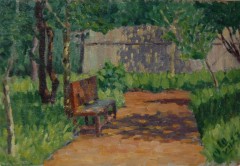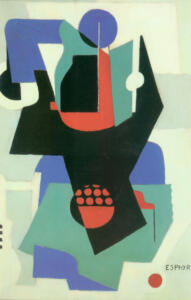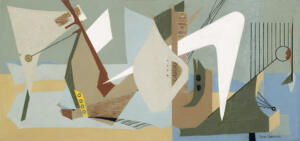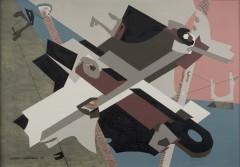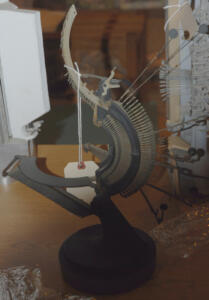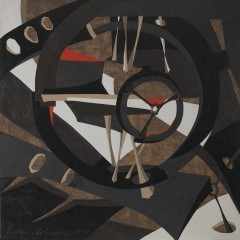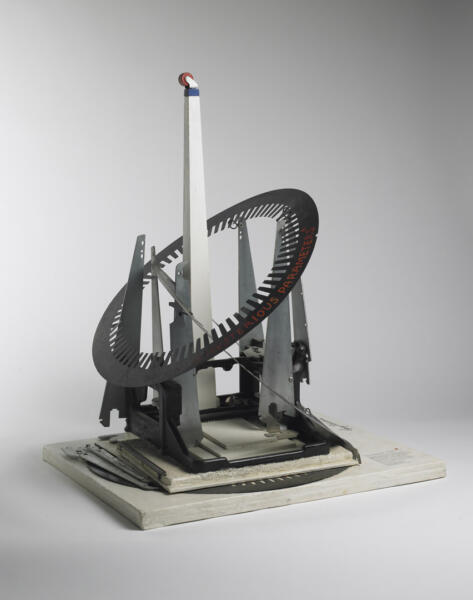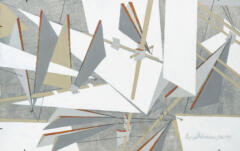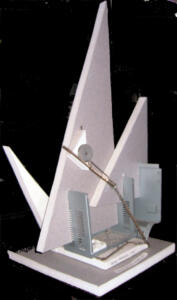1920s – The Beginning
Slobodkina began her art education while living in Harbin, Manchuria, where she received private lessons from the Impressionist painter Pavel Goost. Park Bench in Harbin (1927) was painted under his tutelage.
After immigrating to the United States in 1928, Slobodkina enrolled at the National Academy of Design. She felt stymied by its conservative methodology, which stressed classical forms and ideas. Never one to mince words, Slobodkina wrote of the Academy: “[I] hated every minute of its stupefying, senseless, destrucive method of ‘teaching’ art.” The only class that Slobodkina found tolerable was Arthur Sinclair Covey’s composition class.
In Autumnal Procession in Ancient Russia (1929-31) – created to fulfill a composition class assignment – one can already detect Slobodkina’s penchant for flat, abstract forms.
View art pieces from the 1920s
1930s – Towards the Abstract
In 1931, Esphyr Slobodkina met Ilya Bolotowsky, a fellow student at the National Academy of Design. This relationship marked a turning point in her personal and professional career.
Bolotowksy, who agreed with Slobodkina’s negative assessment of the Academy, traveled to Europe to study the work of the old masters and the European modernists. Upon returning to the United States, Bolotowsky shared his new-found knowledge with Slobodkina, who eagerly absorbed these ideas. She wrote, “Here, at last, was a concrete chance to really learn something about th technique, the meaning, the history of painting.” Bolotwosky became her most important mentor, and for a brief time, her husband (the two married in 1933 but separated in 1936).
Slobodkina’s artistic stye in this decade evolves from explorations in post-Impressionism and Cubism to pure abstraction. In 1936, Slobodkina and Bolotowsky were among the founders of the influential American Abstract Artists – a group of New York City-based artists dedicated to the exhibition and promotion of abstract art.
View art pieces from the 1930s
1940s – Slobodkina’s Work Gains Attention
During the 1940s, Slobodkina developed a mature abstract style and an impressive exhibition record for a young artist.
An active member of the American Abstract Artists, she served as the group’s treasurer in 1924 and secretary from 1945-1960. She participated in AAA annual exhibitions and other important group and solo shows in New York City.
A.E. Gallatin organized Slobodkina’s first major one-person exhibition in 1942 at his Museum of Living Art. In a review of this show, art critic Henry McBride noted that Slobodkina “has refinement, good color, and a sense of picture-making among her assets.”
View art pieces from the 1940s
1950s – A Classic Among Abstractionist Painters
By 1950, Slobodkina was living and working in Great Neck, Long Island (she purchased the home in 1948), and creating larger scale canvases in her new – much bigger – suburban studio. Rejecting Abstract Expressionism as the “drip, splash, and smudge school,” Slobodkina resolutely continued to create tightly controlled geometric canvases.
Slobodkina still actively exhibited in New York City, achieving some of her greatest critical successes during this decade. In 1952, Slobodkina exhibited her Composition with White Ovals in the Whitney Annual, which the Museum subsequently purchased (she was also represented in the Whitney annuals of 1950, 1951, 1953, 1955, and 1958).
In 1954, art critic Emily Genauer declared Slobodkina “a classic among abstractionist painters.”
View art pieces from the 1950s
1960s – A Continuing Tradition of Geometric Abstract Art
Although Slobodkina’s work in the 1960s could be considered geometric abstraction—it is defined by clear, hard edges painted between geometric shapes—it remained closer to Cubism with its overlapping planes of color. She may have been influenced to some extent by the size and scale of hard-edge painting and Minimal Art, but she continued to work independently, outside the parameters of these movements.
Her captivating painting Triptych in Old Rose, 1964, combines three panels to create a larger painting, but the overlapping forms and eccentric shapes do not suggest the simplified and often much larger, hard-edge paintings of Kenneth Noland, Ellsworth Kelly, and Frank Stella.
View art pieces from the 1960s
1970s – Drastic Changes
During the 1970s, Slobodkina struggled to cope with a number of personal tragedies.
While still grieving the death of her her second husband, William Urquhart, who passed away in 1963 only three years after their marriage, Slobodkina lost her brother, a favorite cousin, her aunt, and long-time friends George L.K. Morris, Suzy Frelinghuysen, and Alice Mason. To cope with a deep and mounting depression, Slobodkina began writing her Notes for A Biographer – an 1100-page autobiography – in 1970.
In 1978, Slobodkina moved to Hallandale, Florida, with her mother and her sister Tamara. She had a one-person show in Florida at the Hollywood Art Museum the next year.
View art pieces from the 1970s
1980s – Rediscovered as a Pioneer of American Abstract Art
New attention was focused on Slobodkina’s work in the 1980s, when she was rediscovered as a pioneer of American abstract art. In 1980, her paintings from the 1930s and 1940s were featured in New York City in an exhibition at the Sid Deutsch Gallery. With additional shows at the Sid Deutsch Gallery in 1982, 1985, and 1988, her work again became well-known among curators and collectors [128].
In 1983, two of Slobodkina’s works, Construction No. 3, 1935, and Ancient Sea Song, 1943, were exhibited in Abstract Painting and Sculpture in America, 1927—1944 at the Museum of Art, Carnegie Institute, in Pittsburgh and traveled to the Whitney Museum of American Art in New York City in 1984 [129]. This landmark exhibition presented the first comprehensive study of abstract art in the United States from 1927, when Gallatin established the Gallery of Living Art, until 1944, the year of Mondrian’s death [130]. In this exhibition, curators John R. Lane and Susan C. Larsen brought the early work of Esphyr Slobodkina and many of her abstract artist-colleagues to public attention in a major New York museum.
View art pieces from the 1980s
1990s – Still Going Strong
In 1991, Slobodkina relocated to West Hartford, CT to oversee the construction of the Slobodkina/Urquhart Children’s Reading Room – a building she funded and designed for the University of Hartford. She decorated the interior with twenty-six paper and cloth collage murals that recreate illustrations from her first children’s book, Mary and the Poodies.
In 1999, Slobodkina moved to her final home in Glen Head, New York, and established the Slobodkina Foundation. Throughout her 80s, Slobodkina continued to actively produce and exhibit artwork, even exploring new media. For example, she began deconstructing computers and using the parts to create assemblages.
View art pieces from the 1990s
2000s – Final Years
Slobodkina continued to produced art until shortly before her death on July 22, 2002.
